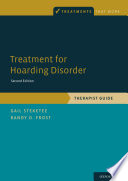

Most ebook files are in PDF format, so you can easily read them using various software such as Foxit Reader or directly on the Google Chrome browser.
Some ebook files are released by publishers in other formats such as .awz, .mobi, .epub, .fb2, etc. You may need to install specific software to read these formats on mobile/PC, such as Calibre.
Please read the tutorial at this link. https://ebooknice.com/page/post?id=faq
We offer FREE conversion to the popular formats you request; however, this may take some time. Therefore, right after payment, please email us, and we will try to provide the service as quickly as possible.
For some exceptional file formats or broken links (if any), please refrain from opening any disputes. Instead, email us first, and we will try to assist within a maximum of 6 hours.
EbookNice Team

Status:
Available4.6
14 reviews
ISBN-10 : 019933496X
ISBN-13 : 9780199334964
Author: Gail Steketee, Randy O. Frost
The relationship people have with their possessions ranges from purely utilitarian to intensely emotional. For most people, their personal possessions provide them with a sense of security, comfort, and pleasure. However, if someone loses the ability to distinguish useful or important possessions from those that make life overly complicated, the objects can become a prison. For people who suffer from Hoarding Disorder (HD), the process of getting rid of unneeded objects is not easy. For them, possessions never "feel" unneeded and trying to get rid of them is an excruciating emotional ordeal. This Second Edition of Treatment for Hoarding Disorder is the culmination of more than 20 years of research on understanding hoarding and building an effective intervention to address its myriad components. Thoroughly updated and reflective of changes made to the Fifth Edition of the Diagnostic and Statistical Manual for Mental Disorders (DSM-5), this second edition of the Therapist Guide and accompanying client Workbook outlines an empirically supported and effective CBT program for treating hoarding disorder. This Therapist Guide is written for mental health clinicians-psychologists, social workers, psychiatrists, counselors, and psychiatric nurses-to guide effective treatment of people with hoarding disorder. It provides numerous assessment and intervention forms to help clients use the methods described in the intervention. A major goal of the treatment is to recapture the positive role of possessions in the lives of people with hoarding problems, and strategies are outlined for sustaining gains and making further progress, as well as for managing stressful life events that can provoke problematic acquiring and difficulty discarding.
Chapter 1 Introduction to Hoarding Disorder
Chapter 2 Evidence-Based Treatment for Hoarding Disorder
Chapter 3 Assessing Hoarding
Chapter 4 Case Formulation
Chapter 5 Enhancing Motivation
Chapter 6 Planning Treatment
Chapter 7 Reducing Acquiring
Chapter 8 Training Skills
Chapter 9 Making Decisions About Saving and Discarding
Chapter 10 Cognitive Strategies
Chapter 11 Complications in the Treatment of Hoarding Disorder
Chapter 12 Maintaining Gains
new treatment for hoarding disorder
evidence based treatment for hoarding disorder
most effective treatment for hoarding disorder
first line treatment for hoarding disorder
the most effective medication treatment for hoarding disorder is
Tags: Treatment, Hoarding Disorder, Gail Steketee, Randy Frost